Zoom
Trash
Related: Konbaung Dynasty (1752–1885)
- Shang dynasty
- Han
- Eighteenth Dynasty
- Ninteenth Dynasty
- Education
- Enterprise

Liu bang han dynasty. Timeline of Chinese History. Timeline of Chinese History from the Peking Man through the modern day.
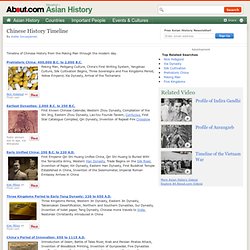
Prehistoric China: 400,000 B.C. to 2,000 B.C. Peking Man, Peiligang Culture, China's First Writing System, Yangshao Culture, Silk Cultivation Begins, Three Sovereigns and Five Kingdoms Period, Yellow Emperor, Xia Dynasty, Arrival of the Tocharians Earliest Dynasties: 2,000 B.C. to 250 B.C. Public domain due to age, via Wikipedia First Known Chinese Calendar, Western Zhou Dynasty, Compilation of the Shi Jing, Eastern Zhou Dynasty, Lao-tzu Founds Taoism, Confucius, First Star Catalogue Compiled, Qin Dynasty, Invention of Repeat-Fire Crossbow Early Unified China: 250 B.C. to 220 A.D.
The Rise and Fall of the Imperial Han. Authored by Jonathan Wu Before the Han Dynasty was formed, the land suffered under the tyranny of the Qin rule.
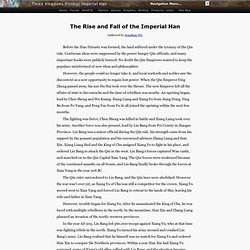
Confucian ideas were suppressed by the power hungry Qin officials, and many important books were publicly burned. No doubt the Qin Emperors wanted to keep the populace uninformed of new ideas and philosophies. However, the people could no longer take it, and local warlords and nobles saw the discontent as a new opportunity to regain lost power. When the Qin Emperor Ying Zheng passed away, his son Hu Hai took over the throne.
The fighting was fierce, Chen Sheng was killed in battle and Xiang Liang took over his army. The Han Dynasty - Ancient China for Kids. New things happened during Han times.
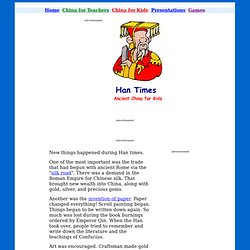
One of the most important was the trade that had begun with ancient Rome via the "silk road". There was a demand in the Roman Empire for Chinese silk. That brought new wealth into China, along with gold, silver, and precious gems. Another was the invention of paper. Paper changed everything! Art was encouraged. In the sciences, great strides were made in medicine. Education was important in Han times. The rich did not send their kids to public school. Most people in Han times were peasant farmers. Han Dynasty, Han Dynasty History, History of Ancient China. Han Dynaty played an important role in history of China.
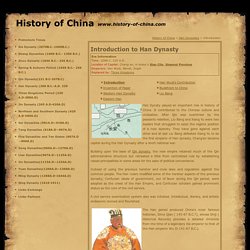
It contributed to the Chinese culture and civilization. After Qin was overthrew by the peasants rebellion, Liu Bang and Xiang Yu were two leaders that struggled to seize the regime position of a new dyansty. They have gone against each other and at last Liu Bang defeated Xiang Yu to be the first emperor of Han dynasty. Chang’an became capital during the Han Dynasty after a short national war. Building upon the base of Qin dynasty, the new empire retained much of the Qin administrative structure but retreated a little from centralized rule by establishing vassal principalities in some areas for the sake of political convenience. Instead of using the previous harsher and crule laws and regulation against the common people.
A civil service examination system also was initiated. The Han period produced China's most famous historian, Sima Qian ( 145-87 B.C.?) Technological advances also marked this period. Society and culture of the Han Dynasty. The Han dynasty (206 BCE – 221 CE) was a period of ancient China divided by the Western Han (206 BCE – 9 CE) and Eastern Han (25–220 CE) periods, when the capital cities were located at Chang'an and Luoyang, respectively.
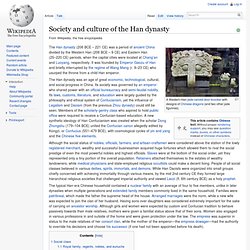
It was founded by Emperor Gaozu of Han and briefly interrupted by the regime of Wang Mang (r. 9–23 CE) who usurped the throne from a child Han emperor. The typical Han-era Chinese household contained a nuclear family with an average of four to five members, unlike in later dynasties when multiple generations and extended family members commonly lived in the same household. Chinese history timeline. Timeline of Chinese history. The following is a timeline of the history of China.
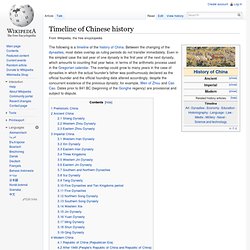
Between the changing of the dynasties, most dates overlap as ruling periods do not transfer immediately. Even in the simplest case the last year of one dynasty is the first year of the next dynasty, which amounts to counting that year twice, in terms of the arithmetic process used in the Gregorian calendar. The overlap could grow to many years in the case of dynasties in which the actual founder's father was posthumously declared as the official founder and the official founding date altered accordingly, despite the concurrent existence of the previous dynasty; for example, Wen of Zhou and Cao Cao. Dates prior to 841 BC (beginning of the Gonghe regency) are provisional and subject to dispute. Prehistoric China[edit] Ancient China[edit] Shang Dynasty[edit] Western Zhou Dynasty[edit] Eastern Zhou Dynasty[edit] Imperial China[edit] Western Han Dynasty[edit] Xin Dynasty[edit] Lü Clan Disturbance. The Lü Clan Disturbance (Traditional Chinese: 呂氏之亂) (180 BC) refers to a political disturbance after the death of Grand Empress Dowager Lü of Han Dynasty, the aftermaths of which saw the clan of the deceased empress' family, the Lü consort clan being overthrown from their seats of power and massacred, the deposing of the puppet Emperor Houshao, and the accession to the throne of Emperor Wen.

Sometimes the term also encompasses to the total domination of the political scene by Grand Empress Dowager Lü and her clan after the death of her son Emperor Hui (188 BC) in an extent even greater than during his reign, and this article will discuss events during that period as well. (The term "the Lü Clan Disturbance" itself is a non-neutral one, used by the officials who overthrew them and historians who supported their political theories, but is used here not to cast any judgment on the Lüs, but because it is commonly used.)
Death of Grand Empress Dowager Lü[edit] Impact[edit] Sino-Xiongnu War. The Han–Xiongnu War,[1] also known as the Sino-Xiongnu War,[2] was a series of military battles fought between the Chinese Han empire and the Xiongnu confederated state from 133 BC to 89 AD.
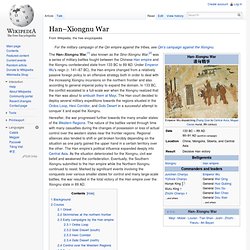
Under Emperor Wu's reign (r. 141–87 BC), the Han empire changed from a relatively passive foreign policy to an offensive strategy both in order to deal with the increasing Xiongnu incursions on the northern frontier and also according to general imperial policy to expand the domain. In 133 BC, the conflict escalated to a full-scale war when the Xiongnu realized that the Han was about to ambush them at Mayi. The Han court decided to deploy several military expeditions towards the regions situated in the Ordos Loop, Hexi Corridor, and Gobi Desert in a successful attempt to conquer it and expel the Xiongnu. Www.uscpf.org/v2/pdf/chinesehistorytimeline.pdf. History Timeline.